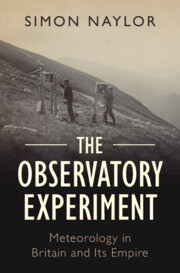
- Publisher:
- Cambridge University Press
- Online publication date:
- October 2024
- Print publication year:
- 2024
- Online ISBN:
- 9781009207225

In this innovative history of the science of meteorology, Simon Naylor focuses our attention on the spaces in which it was pursued: meteorological observatories. During the nineteenth century, meteorologists established or converted sites where observers and their instruments could be housed, where they collected and analysed data and developed meteorological theories. He examines a number of these sites around the British Empire, along with the governmental, military and commercial networks connecting them. Taking many shapes to capture the weather in different environments, these observatories brought various social groups into contact with the practice of science, including sailors on naval surveying vessels, climbers ascending Scottish peaks, and families checking their rain gauges at home. Through a study of these spaces, Naylor argues for the treatment of meteorology as an experimental observatory science, on which the development of knowledge about local, regional, national and global weather and climate relied.
‘Admiralty ships, a Scottish mountaintop, Bombay harbour and even the pages of a modest rainfall periodical - Naylor brilliantly illustrates where and how data counts. As he traces the stories of these places, Naylor raises provocative questions about the ideals of collective science, and about the techniques of accumulation that guide our assumptions about the future of our weather and our weather data alike.’
Katharine Anderson - York University
‘A sweeping study of how atmospheres, airs, and winds came to be known, and in exciting new ways across the nineteenth century. Meteorology was entirely refashioned, Naylor shows us, Victorian observers and observatories making new skyscapes, seascapes and landscapes that shape our present.’
Alison Bashford - Alison Bashford, University of New South Wales, Sydney
‘This deeply researched book traces the fascinating twists and turns of early scientific meteorology. Naylor’s meticulous descriptions will make readers marvel at the complex quest for weather data that consumed Britain’s professionals and amateurs throughout the nineteenth century, eventually producing remarkable globe-spanning networks that seem commonplace today.’
Maria Lane - University of New Mexico
 Loading metrics...
Loading metrics...
* Views captured on Cambridge Core between #date#. This data will be updated every 24 hours.
Usage data cannot currently be displayed.